Mutian Xu
TASTE-Rob: Advancing Video Generation of Task-Oriented Hand-Object Interaction for Generalizable Robotic Manipulation
Mar 14, 2025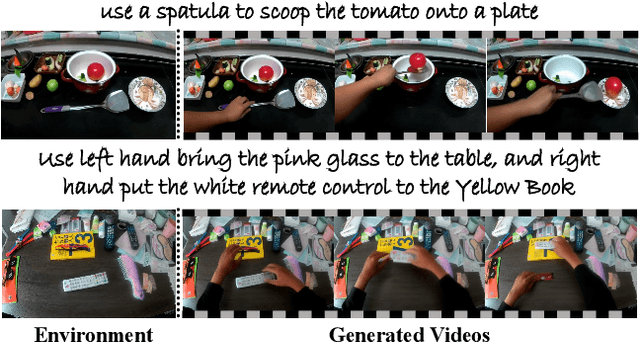

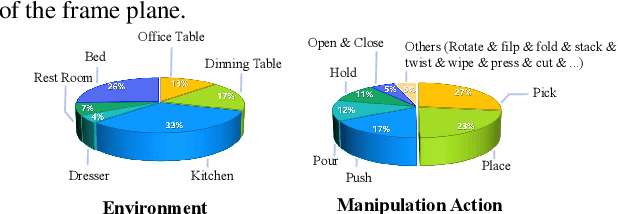
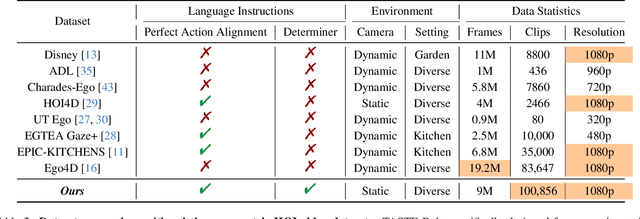
Abstract:We address key limitations in existing datasets and models for task-oriented hand-object interaction video generation, a critical approach of generating video demonstrations for robotic imitation learning. Current datasets, such as Ego4D, often suffer from inconsistent view perspectives and misaligned interactions, leading to reduced video quality and limiting their applicability for precise imitation learning tasks. Towards this end, we introduce TASTE-Rob -- a pioneering large-scale dataset of 100,856 ego-centric hand-object interaction videos. Each video is meticulously aligned with language instructions and recorded from a consistent camera viewpoint to ensure interaction clarity. By fine-tuning a Video Diffusion Model (VDM) on TASTE-Rob, we achieve realistic object interactions, though we observed occasional inconsistencies in hand grasping postures. To enhance realism, we introduce a three-stage pose-refinement pipeline that improves hand posture accuracy in generated videos. Our curated dataset, coupled with the specialized pose-refinement framework, provides notable performance gains in generating high-quality, task-oriented hand-object interaction videos, resulting in achieving superior generalizable robotic manipulation. The TASTE-Rob dataset will be made publicly available upon publication to foster further advancements in the field.
SAMPro3D: Locating SAM Prompts in 3D for Zero-Shot Scene Segmentation
Nov 29, 2023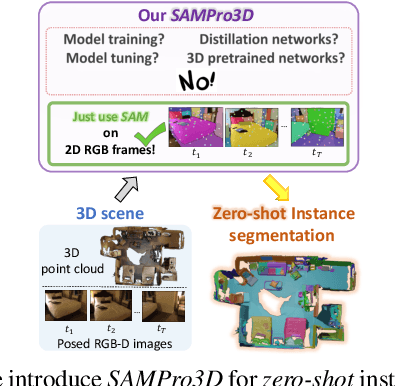

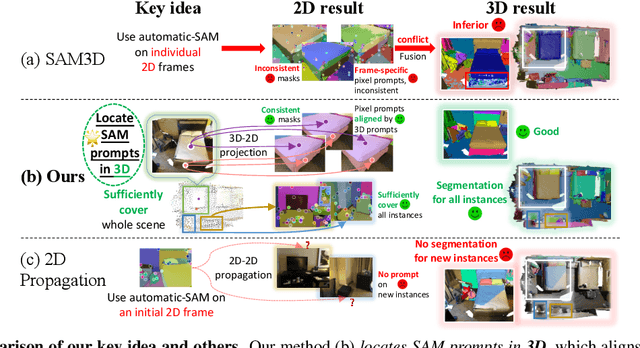

Abstract:We introduce SAMPro3D for zero-shot 3D indoor scene segmentation. Given the 3D point cloud and multiple posed 2D frames of 3D scenes, our approach segments 3D scenes by applying the pretrained Segment Anything Model (SAM) to 2D frames. Our key idea involves locating 3D points in scenes as natural 3D prompts to align their projected pixel prompts across frames, ensuring frame-consistency in both pixel prompts and their SAM-predicted masks. Moreover, we suggest filtering out low-quality 3D prompts based on feedback from all 2D frames, for enhancing segmentation quality. We also propose to consolidate different 3D prompts if they are segmenting the same object, bringing a more comprehensive segmentation. Notably, our method does not require any additional training on domain-specific data, enabling us to preserve the zero-shot power of SAM. Extensive qualitative and quantitative results show that our method consistently achieves higher quality and more diverse segmentation than previous zero-shot or fully supervised approaches, and in many cases even surpasses human-level annotations. The project page can be accessed at https://mutianxu.github.io/sampro3d/.
RichDreamer: A Generalizable Normal-Depth Diffusion Model for Detail Richness in Text-to-3D
Nov 28, 2023Abstract:Lifting 2D diffusion for 3D generation is a challenging problem due to the lack of geometric prior and the complex entanglement of materials and lighting in natural images. Existing methods have shown promise by first creating the geometry through score-distillation sampling (SDS) applied to rendered surface normals, followed by appearance modeling. However, relying on a 2D RGB diffusion model to optimize surface normals is suboptimal due to the distribution discrepancy between natural images and normals maps, leading to instability in optimization. In this paper, recognizing that the normal and depth information effectively describe scene geometry and be automatically estimated from images, we propose to learn a generalizable Normal-Depth diffusion model for 3D generation. We achieve this by training on the large-scale LAION dataset together with the generalizable image-to-depth and normal prior models. In an attempt to alleviate the mixed illumination effects in the generated materials, we introduce an albedo diffusion model to impose data-driven constraints on the albedo component. Our experiments show that when integrated into existing text-to-3D pipelines, our models significantly enhance the detail richness, achieving state-of-the-art results. Our project page is https://lingtengqiu.github.io/RichDreamer/.
Free-ATM: Exploring Unsupervised Learning on Diffusion-Generated Images with Free Attention Masks
Aug 13, 2023Abstract:Despite the rapid advancement of unsupervised learning in visual representation, it requires training on large-scale datasets that demand costly data collection, and pose additional challenges due to concerns regarding data privacy. Recently, synthetic images generated by text-to-image diffusion models, have shown great potential for benefiting image recognition. Although promising, there has been inadequate exploration dedicated to unsupervised learning on diffusion-generated images. To address this, we start by uncovering that diffusion models' cross-attention layers inherently provide annotation-free attention masks aligned with corresponding text inputs on generated images. We then investigate the problems of three prevalent unsupervised learning techniques ( i.e., contrastive learning, masked modeling, and vision-language pretraining) and introduce customized solutions by fully exploiting the aforementioned free attention masks. Our approach is validated through extensive experiments that show consistent improvements in baseline models across various downstream tasks, including image classification, detection, segmentation, and image-text retrieval. By utilizing our method, it is possible to close the performance gap between unsupervised pretraining on synthetic data and real-world scenarios.
REC-MV: REconstructing 3D Dynamic Cloth from Monocular Videos
May 23, 2023



Abstract:Reconstructing dynamic 3D garment surfaces with open boundaries from monocular videos is an important problem as it provides a practical and low-cost solution for clothes digitization. Recent neural rendering methods achieve high-quality dynamic clothed human reconstruction results from monocular video, but these methods cannot separate the garment surface from the body. Moreover, despite existing garment reconstruction methods based on feature curve representation demonstrating impressive results for garment reconstruction from a single image, they struggle to generate temporally consistent surfaces for the video input. To address the above limitations, in this paper, we formulate this task as an optimization problem of 3D garment feature curves and surface reconstruction from monocular video. We introduce a novel approach, called REC-MV, to jointly optimize the explicit feature curves and the implicit signed distance field (SDF) of the garments. Then the open garment meshes can be extracted via garment template registration in the canonical space. Experiments on multiple casually captured datasets show that our approach outperforms existing methods and can produce high-quality dynamic garment surfaces. The source code is available at https://github.com/GAP-LAB-CUHK-SZ/REC-MV.
MVImgNet: A Large-scale Dataset of Multi-view Images
Mar 10, 2023



Abstract:Being data-driven is one of the most iconic properties of deep learning algorithms. The birth of ImageNet drives a remarkable trend of "learning from large-scale data" in computer vision. Pretraining on ImageNet to obtain rich universal representations has been manifested to benefit various 2D visual tasks, and becomes a standard in 2D vision. However, due to the laborious collection of real-world 3D data, there is yet no generic dataset serving as a counterpart of ImageNet in 3D vision, thus how such a dataset can impact the 3D community is unraveled. To remedy this defect, we introduce MVImgNet, a large-scale dataset of multi-view images, which is highly convenient to gain by shooting videos of real-world objects in human daily life. It contains 6.5 million frames from 219,188 videos crossing objects from 238 classes, with rich annotations of object masks, camera parameters, and point clouds. The multi-view attribute endows our dataset with 3D-aware signals, making it a soft bridge between 2D and 3D vision. We conduct pilot studies for probing the potential of MVImgNet on a variety of 3D and 2D visual tasks, including radiance field reconstruction, multi-view stereo, and view-consistent image understanding, where MVImgNet demonstrates promising performance, remaining lots of possibilities for future explorations. Besides, via dense reconstruction on MVImgNet, a 3D object point cloud dataset is derived, called MVPNet, covering 87,200 samples from 150 categories, with the class label on each point cloud. Experiments show that MVPNet can benefit the real-world 3D object classification while posing new challenges to point cloud understanding. MVImgNet and MVPNet will be publicly available, hoping to inspire the broader vision community.
MM-3DScene: 3D Scene Understanding by Customizing Masked Modeling with Informative-Preserved Reconstruction and Self-Distilled Consistency
Dec 20, 2022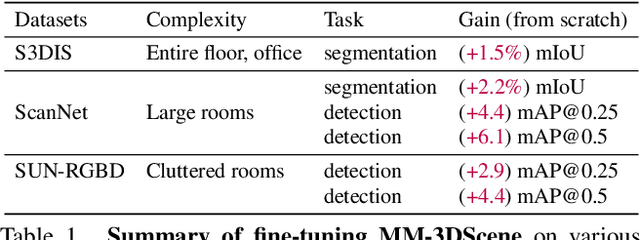
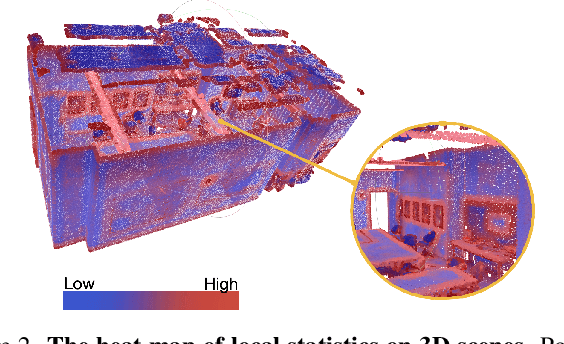
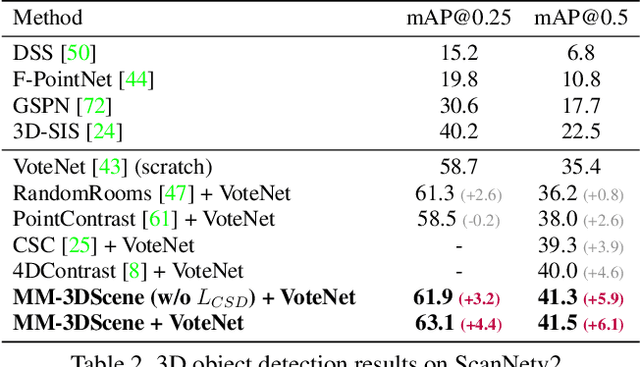
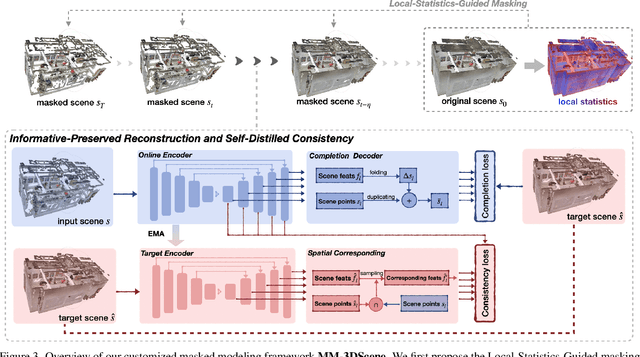
Abstract:Masked Modeling (MM) has demonstrated widespread success in various vision challenges, by reconstructing masked visual patches. Yet, applying MM for large-scale 3D scenes remains an open problem due to the data sparsity and scene complexity. The conventional random masking paradigm used in 2D images often causes a high risk of ambiguity when recovering the masked region of 3D scenes. To this end, we propose a novel informative-preserved reconstruction, which explores local statistics to discover and preserve the representative structured points, effectively enhancing the pretext masking task for 3D scene understanding. Integrated with a progressive reconstruction manner, our method can concentrate on modeling regional geometry and enjoy less ambiguity for masked reconstruction. Besides, such scenes with progressive masking ratios can also serve to self-distill their intrinsic spatial consistency, requiring to learn the consistent representations from unmasked areas. By elegantly combining informative-preserved reconstruction on masked areas and consistency self-distillation from unmasked areas, a unified framework called MM-3DScene is yielded. We conduct comprehensive experiments on a host of downstream tasks. The consistent improvement (e.g., +6.1 mAP@0.5 on object detection and +2.2% mIoU on semantic segmentation) demonstrates the superiority of our approach.
A Survey on Graph Neural Networks and Graph Transformers in Computer Vision: A Task-Oriented Perspective
Oct 06, 2022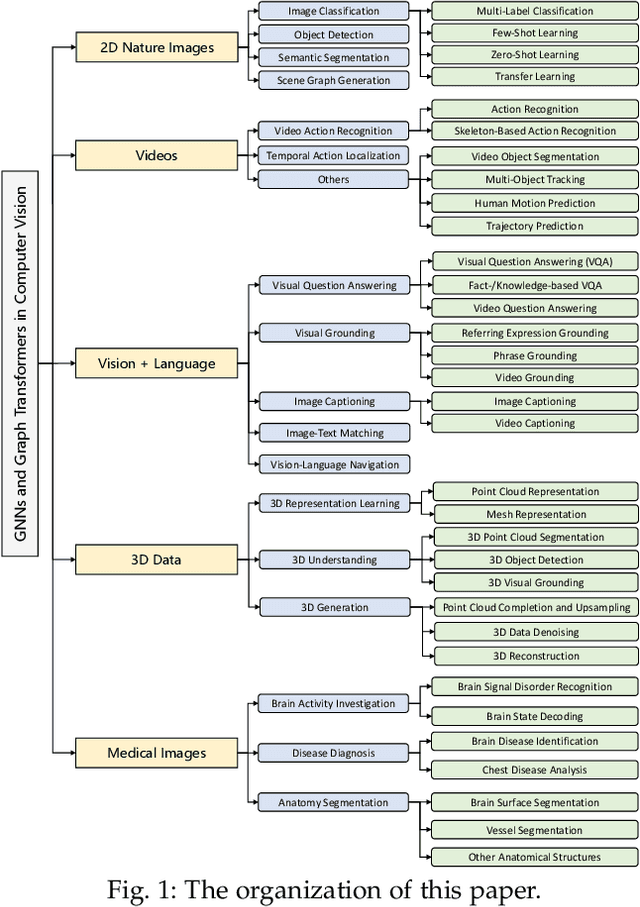
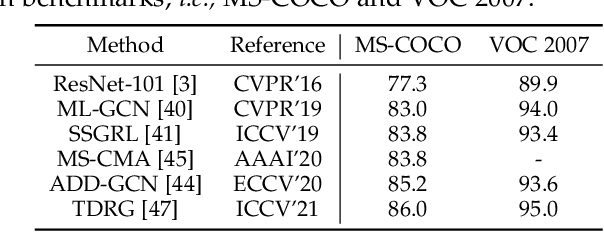

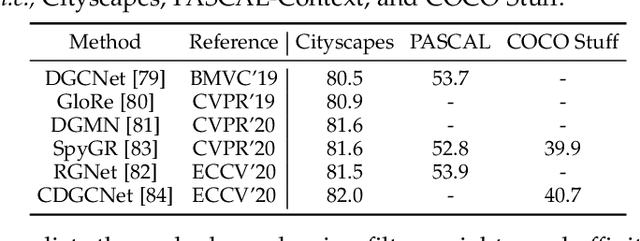
Abstract:Graph Neural Networks (GNNs) have gained momentum in graph representation learning and boosted the state of the art in a variety of areas, such as data mining (\emph{e.g.,} social network analysis and recommender systems), computer vision (\emph{e.g.,} object detection and point cloud learning), and natural language processing (\emph{e.g.,} relation extraction and sequence learning), to name a few. With the emergence of Transformers in natural language processing and computer vision, graph Transformers embed a graph structure into the Transformer architecture to overcome the limitations of local neighborhood aggregation while avoiding strict structural inductive biases. In this paper, we present a comprehensive review of GNNs and graph Transformers in computer vision from a task-oriented perspective. Specifically, we divide their applications in computer vision into five categories according to the modality of input data, \emph{i.e.,} 2D natural images, videos, 3D data, vision + language, and medical images. In each category, we further divide the applications according to a set of vision tasks. Such a task-oriented taxonomy allows us to examine how each task is tackled by different GNN-based approaches and how well these approaches perform. Based on the necessary preliminaries, we provide the definitions and challenges of the tasks, in-depth coverage of the representative approaches, as well as discussions regarding insights, limitations, and future directions.
TO-Scene: A Large-scale Dataset for Understanding 3D Tabletop Scenes
Mar 21, 2022



Abstract:Many basic indoor activities such as eating or writing are always conducted upon different tabletops (e.g., coffee tables, writing desks). It is indispensable to understanding tabletop scenes in 3D indoor scene parsing applications. Unfortunately, it is hard to meet this demand by directly deploying data-driven algorithms, since 3D tabletop scenes are rarely available in current datasets. To remedy this defect, we introduce TO-Scene, a large-scale dataset focusing on tabletop scenes, which contains 20,740 scenes with three variants. To acquire the data, we design an efficient and scalable framework, where a crowdsourcing UI is developed to transfer CAD objects onto tables from ScanNet, then the output tabletop scenes are simulated into real scans and annotated automatically. Further, a tabletop-aware learning strategy is proposed for better perceiving the small-sized tabletop instances. Notably, we also provide a real scanned test set TO-Real to verify the practical value of TO-Scene. Experiments show that the algorithms trained on TO-Scene indeed work on the realistic test data, and our proposed tabletop-aware learning strategy greatly improves the state-of-the-art results on both 3D semantic segmentation and object detection tasks. TO-Scene and TO-Real, plus Web UI, will all be publicly available.
PAConv: Position Adaptive Convolution with Dynamic Kernel Assembling on Point Clouds
Apr 26, 2021



Abstract:We introduce Position Adaptive Convolution (PAConv), a generic convolution operation for 3D point cloud processing. The key of PAConv is to construct the convolution kernel by dynamically assembling basic weight matrices stored in Weight Bank, where the coefficients of these weight matrices are self-adaptively learned from point positions through ScoreNet. In this way, the kernel is built in a data-driven manner, endowing PAConv with more flexibility than 2D convolutions to better handle the irregular and unordered point cloud data. Besides, the complexity of the learning process is reduced by combining weight matrices instead of brutally predicting kernels from point positions. Furthermore, different from the existing point convolution operators whose network architectures are often heavily engineered, we integrate our PAConv into classical MLP-based point cloud pipelines without changing network configurations. Even built on simple networks, our method still approaches or even surpasses the state-of-the-art models, and significantly improves baseline performance on both classification and segmentation tasks, yet with decent efficiency. Thorough ablation studies and visualizations are provided to understand PAConv. Code is released on https://github.com/CVMI-Lab/PAConv.
 Add to Chrome
Add to Chrome Add to Firefox
Add to Firefox Add to Edge
Add to Edge